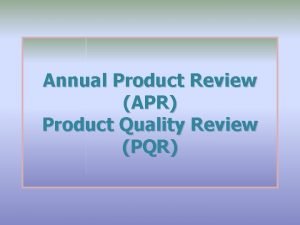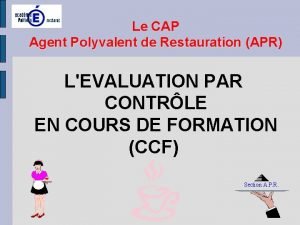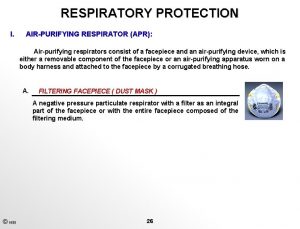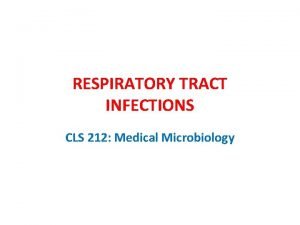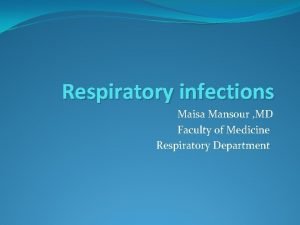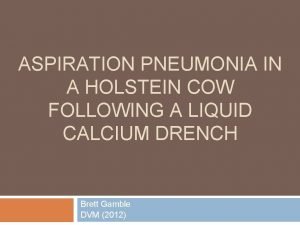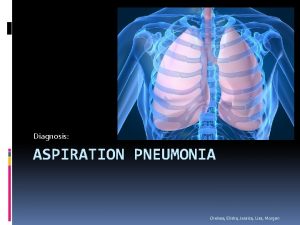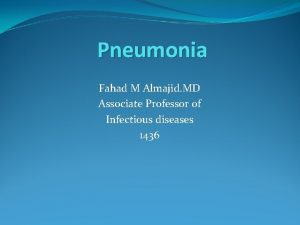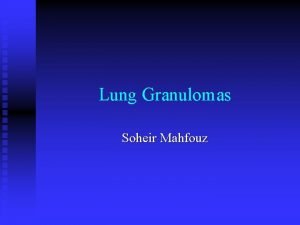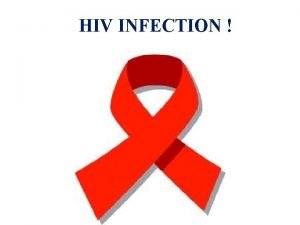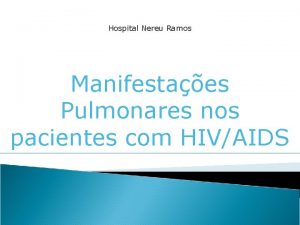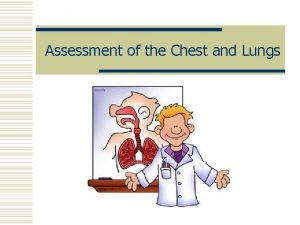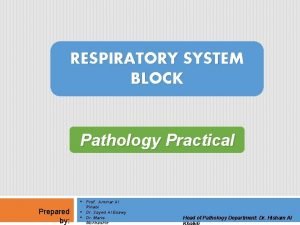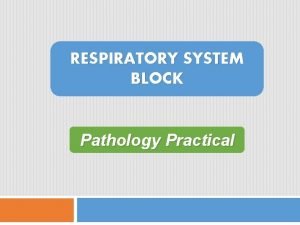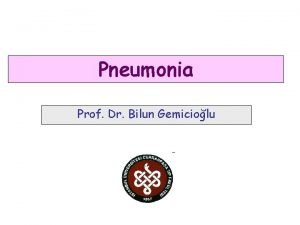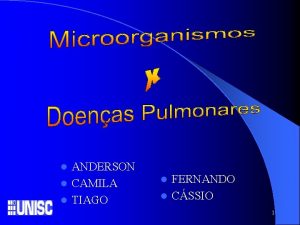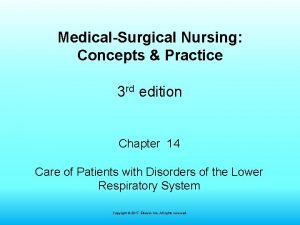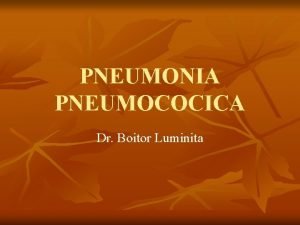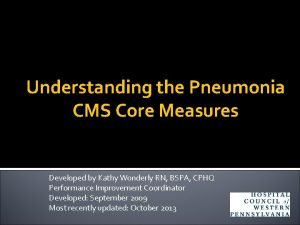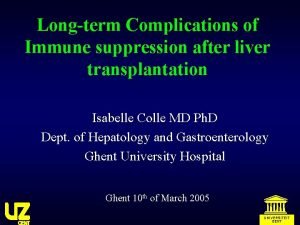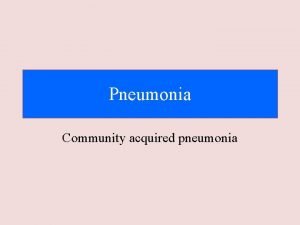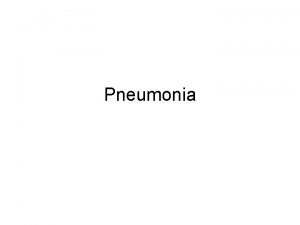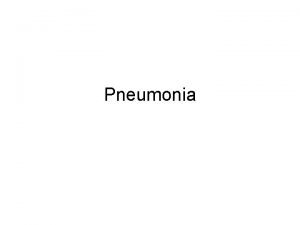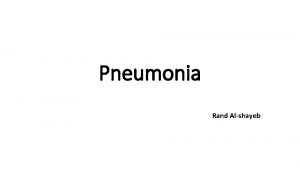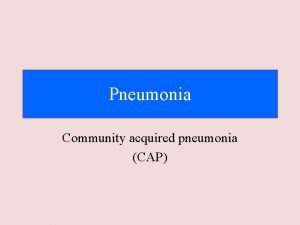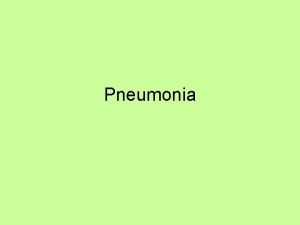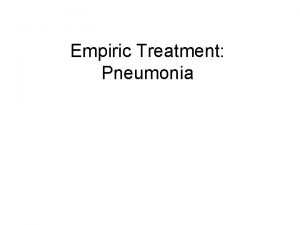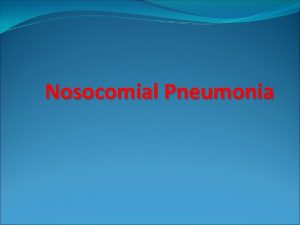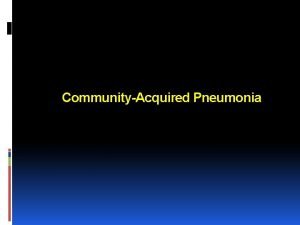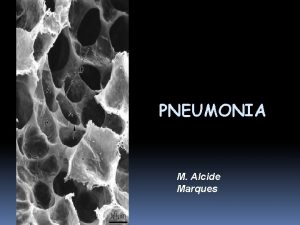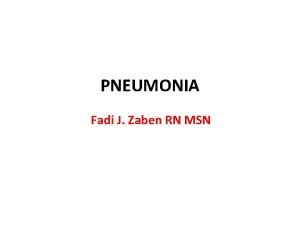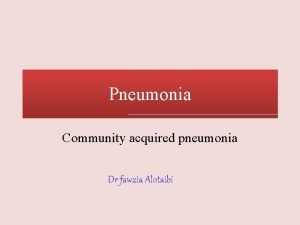Pneumonia Dr Samet M Apr 2011 Yazd University










































- Slides: 42

Pneumonia Dr. Samet. M Apr 2011 -Yazd University Harrison's - PRINCIPLES OF INTERNAL MEDICINE 7 th Edition

Definition 1. 2. § § Ø Ø Ø an infection of the pulmonary parenchyma is often misdiagnosed, mistreated, and underestimated was typically classified as : Community-Acquired Pneumonia (CAP) Health Care–Associated Pneumonia (HCAP) subcategories of HCAP including Hospital-acquired pneumonia (HAP) Ventilator-associated pneumonia (VAP) Factors responsible for infection with multidrug-resistant (MDR) pathogens include : development and widespread use of potent oral antibiotics earlier transfer of patients out of acute-care hospitals to their homes or various lower-acuity facilities increased use of outpatient IV antibiotic therapy general aging of the population more extensive immunomodulatory therapies


Pneumonia classification system Although the new classification system has been helpful in designing empirical antibiotic strategies, it is not without disadvantages For instance » » » » not all MDR pathogens are associated with all risk factors » » » each patient must be considered individually For example the risk of infection with MDR pathogens for a nursing home resident with dementia who can dress, ambulate, and eat is quite different from the risk for a patient who is in a chronic vegetative state with a tracheostomy and a percutaneous feeding tube in place In addition, risk factors for MDR infection do not preclude the development of pneumonia caused by the usual CAP pathogens

Pathophysiology • • Ø Ø Ø Pneumonia results from the proliferation of microbial pathogens at the alveolar level and the host's response to those pathogens Microorganisms gain access to the lower respiratory tract in several ways: » » » » » The most common is by aspiration from the oropharynx Many pathogens are inhaled as contaminated droplets pneumonia occurs via hematogenous spread contiguous extension from an infected pleural or mediastinal space Mechanical factors are critically important in host defense: » » » hairs and turbinates of the nares catch larger inhaled particles branching architecture of the tracheobronchial tree traps particles on the airway lining mucociliary clearance and local antibacterial factors either clear or kill the potential pathogen gag reflex and the cough mechanism normal flora adhering to mucosal cells of the oropharynx resident alveolar macrophages Only when the capacity of the alveolar macrophages to ingest or kill the microorganisms is exceeded does clinical pneumonia become manifest » » » the alveolar macrophages initiate the inflammatory response to bolster lower respiratory tract defenses

Pathophysiology The host inflammatory response, rather than the proliferation of microorganisms, triggers the clinical syndrome of pneumonia ü The release of inflammatory mediators, such as IL-1 and TNF » » » fever ü Chemokines, such as IL-8 and GCSF, stimulate the release of neutrophils and their attraction to the lung » » » peripheral leukocytosis and increased purulent secretions Even erythrocytes can cross the alveolar-capillary membrane, with consequent hemoptysis The capillary leak results in a radiographic infiltrate and rales detectable on auscultation hypoxemia results from alveolar filling some bacterial pathogens appear to interfere with the hypoxic vasoconstriction that would normally occur with fluidfilled alveoli, and this interference can result in severe hypoxemia Increased respiratory drive in the SIRS leads to respiratory alkalosis Dyspnea due to : Decreased compliance due to capillary leak Ø increased respiratory drive Ø infection-related bronchospasm Ø Hypoxemia increased secretions

Pathology The initial phase » » » » edema presence of a proteinaceous exudate—and often of bacteria—in the alveoli This phase is rarely evident in clinical or autopsy specimens because it is so rapidly followed by a red hepatization The second stage » » » » » red hepatization presence of erythrocytes in the cellular intraalveolar exudate neutrophils are also present and are important from the standpoint of host defense Bacteria are occasionally seen in cultures of alveolar specimens The third phase » » » » gray hepatization no new erythrocytes are extravasating, and those already present have been lysed and degraded The neutrophil is the predominant cell fibrin deposition is abundant bacteria have disappeared This phase corresponds with successful containment of the infection and improvement in gas exchange The final phase » » » » » resolution the macrophage is the dominant cell type in the alveolar space the debris of neutrophils, bacteria, and fibrin has been cleared, as has the inflammatory response

Pathology This pattern has been described best for pneumococcal pneumonia and may not apply to pneumonias of all etiologies, especially viral or Pneumocystis pneumonia in VAP, respiratory bronchiolitis may precede the development of a radiologically apparent infiltrate Because of the microaspiration mechanism, a bronchopneumonia pattern is most common in nosocomial pneumonias a lobar pattern is more common in bacterial CAP Despite the radiographic appearance, viral and Pneumocystis pneumonias represent alveolar rather than interstitial processes.

Etiology The extensive list of potential etiologic agents in CAP includes bacteria, fungi, viruses, and protozoa Newly identified pathogens include hantaviruses, metapneumoviruses, the coronavirus (SARS), and community-acquired strains of MRSA Most cases of CAP are caused by relatively few pathogens Streptococcus pneumoniae is most common other organisms must also be considered in light of the patient's risk factors and severity of illness it is most useful to think of the potential causes as either "typical" or "atypical" organisms Typical bacterial pathogens includes : S. pneumoniae, Haemophilus influenzae, S. aureus , gramnegative bacilli such as Klebsiella pneumoniae and Pseudomonas aeruginosa Atypical organisms include : Mycoplasma pneumoniae, Chlamydophila pneumoniae, Legionella spp, respiratory viruses such as influenza viruses, adenoviruses, RSVs The atypical organisms cannot be cultured on standard media, nor can they be seen on Gram's stain are intrinsically resistant to all -lactam agents and must be treated with macrolide, fluoroquinolone, tetracycline Data suggest that a virus may be responsible in up to 18% of cases of CAP In the ~10– 15% of CAP cases that are polymicrobial

a. Influenza A and B viruses, adenoviruses, respiratory syncytial viruses, parainfluenza viruses Anaerobes play a significant role only when an episode of aspiration has occurred days to weeks before presentation for pneumonia. combination of an unprotected airway (alcohol or drug overdose or a seizure disorder) and significant gingivitis constitutes the major risk factor. Anaerobic pneumonias are often complicated by abscess formation and significant empyemas or parapneumonic effusions S. aureus pneumonia is well known to complicate influenza infection. Recently, however, MRSA strains have been reported as primary causes of CAP. While this entity is still relatively uncommon, clinicians must be aware of its potentially serious consequences, such as necrotizing pneumonia. Two important developments have led to this problem: the spread of MRSA from the hospital setting to the community and the emergence of genetically distinct strains of MRSA in the community. These novel CA-MRSA strains have infected healthy individuals who have had no association with health care Unfortunately, despite a careful history and physical examination as well as routine radiographic studies, it is usually impossible to predict the pathogen in a case of CAP with any degree of certainty; in more than half of cases, a specific etiology is never determined. Nevertheless, it is important to consider epidemiologic and risk factors that might suggest certain pathogens



Epidemiology In the US, ~80% of the 4 million CAP cases that occur annually are treated on an outpatient basis The incidence rates are highest at the extremes of age Ø Ø Ø RF for CAP: alcoholism, asthma, immunosuppress, institutionalization, age of 70 Y versus 60– 69 Y RF for pneumococ: dementia, seizure, heart failure, CVA, alcoholism, smoking, COPD, HIV RF for CA-MRSA: Native Americans, homeless youths, men who have sex with men, prison inmates, military recruits, children in day-care centers, and athletes such as wrestlers RF for Enterobacteriaceae: recently hospitalization and/or antibiotic therapy, comorbidities such as alcoholism, heart failure, renal failure RF for P. aeruginosa : as above, severe structural lung disease RF for Legionella: diabetes, hematologic malignancy, cancer, severe renal disease, HIV infection, smoking, male gender, a recent hotel stay or ship cruise

Clinical Manifestations CAP can vary from indolent to fulminant in presentation and from mild to fatal in severity constitutional findings and manifestations limited to the lung and its associated structures fever, tachycardia, chills and/or sweats cough that is either nonproductive or productive of mucoid, purulent, or blood-tinged sputum the patient may be able to speak in full sentences or may be very short of breath If the pleura is involved, the patient may experience pleuritic chest pain Up to 20% of patients may have GI symptoms such as nausea, vomiting, and/or diarrhea Other symptoms may include fatigue, headache, myalgias, and arthralgias An increased respiratory rate and use of accessory muscles of respiration are common Palpation may reveal increased or decreased tactile fremitus Percussion can vary from dull to flat, reflecting underlying consolidated lung and pleural fluid Crackles, bronchial breath sounds, and possibly a pleural friction rub may be heard Severely ill patients who have septic shock are hypotensive and may have evidence of organ failure

Clinical Manifestations The clinical presentation may not be so obvious in the elderly who may initially display new-onset or worsening confusion and few other manifestations.

Diagnosis When confronted with possible CAP, the physician must ask two questions: 1) Is this pneumonia? » » » » » answered by clinical and radiographic methods 2) what is the etiology? » » » » requires the aid of laboratory techniques

Clinical Diagnosis The differential diagnosis includes: Ø infectious Ø noninfectious ******* acute bronchitis, acute exa of chronic bronchitis, heart failure, PTE, radiation The importance of a careful history cannot be overemphasized » » » » cardiac disease may suggest worsening pulmonary edema underlying carcinoma may suggest lung injury secondary to radiation known Epidemiologic clues, such as recent travel to areas with known endemic pathogens Unfortunately, the sensitivity and specificity of the findings on physical examination are less than ideal, averaging 58% and 67%, respectively ********* C-Xray is often necessary

Radiographic findings serve: severity (cavitation or multilobar involvement) suggest an etiologic diagnosis ******* ü pneumatoceles suggest infection with S. Aureus ü upper-lobe cavitating lesion suggests TB CT is rarely necessary but may be of value in a patient with suspected postobstructive pneumonia caused by a tumor or foreign body

Clinical & Radiologic Diagnosis For cases managed on an outpatient basis, the clinical and radiologic assessment is usually all that is done before treatment is started since most laboratory test results are not available soon enough to influence initial management In certain cases, however (influenza virus infection), the availability of rapid point-of-care diagnostic tests and access to specific drugs for treatment and prevention can be very important.

Etiologic Diagnosis The etiology of pneumonia usually cannot be determined on the basis of clinical presentation Except for the 2% of CAP patients who are admitted to the ICU, no data exist to show that treatment directed at a specific pathogen is statistically superior to empirical therapy. The benefits of establishing a microbial etiology can therefore be questioned, particularly in light of the cost of diagnostic testing. a number of reasons can be advanced for attempting an etiologic diagnosis: v Identification of an unexpected pathogen allows narrowing of the initial empirical regimen, which decreases antibiotic selection pressure and may lessen the risk of resistance v Pathogens with important public safety implications, such as TB and influenza virus v without culture and susceptibility data, trends in resistance cannot be followed accurately

Gram's Stain and Culture of Sputum a sputum sample must have >25 neut and <10 squamous epithelial cells per low-power field sensitivity / specificity of the sputum Gram's stain and culture are highly variable » » » » » in cases of proven bacteremic pneumococc, the yield of positive cultures from sputum samples is 50% Some patients, particularly elderly individuals, may not be able to produce an appropriate expectorated sputum sample. The inability to produce sputum can be a consequence of dehydration, and the correction of this condition may result in increased sputum production and a more obvious infiltrate on radiography For patients admitted to the ICU and intubated, a deep-suction aspirate or BAL sample

Blood Cultures 1) The yield from blood cultures, even those obtained before antibiotic therapy, is disappointingly low Only ~5– 14% of cultures of blood from patients hospitalized with CAP are positive the most frequently isolated pathogen is S. Pneumoniae 2) Since recommended empirical regimens all provide pneumococcal coverage, a blood culture positive for this pathogen has little effect on clinical outcome ******* susceptibility data may allow a switch from a broader-spectrum regimen to penicillin in appropriate cases Because of 1) the low yield and 2) the lack of significant impact on outcome, blood cultures are no longer considered de rigueur for all hospitalized CAP patients should have blood cultured : neutropenia secondary to pneumonia Asplenia complement deficiencies chronic liver disease severe CAP

Antigen Tests a) b) Two commercially available tests detect pneumococcal certain Legionella antigens in urine The test for Legionella pneumophila detects only serogroup 1, but this serogroup accounts for most CAP cases of Legionnaires' disease The sensitivity and specificity of the Legionella urine antigen test are as high as 90% and 99% The pneumococcal urine antigen test is also quite sensitive and specific 80% and >90% false-positive results can be obtained with samples from colonized children, but the test is reliable Both tests can detect antigen even after the initiation of appropriate antibiotic therapy and after weeks of illness Other antigen tests include a rapid test for influenza virus and direct fluorescent antibody tests for influenza virus and RSV the test for RSV is only poorly sensitive

Polymerase Chain Reaction PCR tests are available for a number of pathogens, including : L. Pneumophila Mycobacteria a multiplex PCR can detect the nucleic acid of Legionella spp. M. Pneumoniae C. pneumoniae

Serology A fourfold rise in specific Ig. M antibody titer between acute- and convalescentphase serum samples is generally considered diagnostic of infection with the pathogen in question Recently, however, they have fallen out of favor because of the time required to obtain a final result for the convalescent-phase sample

CAP: Treatment Ø Ø Site of Care cost of inpatient management exceeds that of outpatient treatment by a factor of 20 There are currently two sets of criteria: Pneumonia Severity Index (PSI), a prognostic model used to identify patients at low risk of dying the CURB-65 criteria, a severity-of-illness score The PSI is less practical in a busy emergency-room setting because of the need to assess 20 variables

Pneumonia Severity Index (PSI) points are given for 20 variables, including: Age coexisting illness abnormal physical laboratory findings On the basis of the resulting score, patients are assigned to one of five classes with the following mortality rates: class 1, 0. 1% lower admission rates for class 1 and class 2, 0. 6% class 3, 2. 8% » » » » those in class 3 should ideally be admitted to an observation unit class 4, 8. 2% class 5, 29. 2% classes 4 and 5 should be admitted to the hospital

The CURB-65 criteria include five variables: 1) confusion (C) 2) urea >7 mmol/L (U) 3) respiratory rate 30/min (R) 4) blood pressure, systolic 90 mm. Hg or diastolic 60 mm. Hg (B) 5) age 65 years (65) Patients with a score of 0, among whom the 30 -day mortality rate is 1. 5% » » » can be treated outside the hospital score of 2, the 30 -day mortality rate is 9. 2% » » » » should be admitted to the hospital scores of 3, mortality rates are 22% overall » » » » may require admission to an ICU

Resistance(CA-MRSA ) CAP due to MRSA may be caused by infection with : Ø the classic hospital-acquired strains » » » » classified as HAP in the past, now be classified as HCAP Ø the more recently identified, genotypically and phenotypically distinct community-acquired strains Methicillin resistance in S. aureus is determined by the mec. A gene, which encodes for resistance to all -lactam drugs At least five staphylococcal chromosomal cassette mec (SCCmec) types have been described: v The typical hospital-acquired strain usually has type II or III v whereas CA-MRSA has a type IV SCCmec element CA-MRSA isolates tend to be less resistant than the older hospital-acquired strains and are often susceptible to : TMP-SMX Clindamycin in addition to vancomycin and linezolid Tetracycline CA-MRSA strains may also carry genes for superantigens » » » » » enterotoxins B and C and Panton. Valentine leukocidin » » » » a membrane-tropic toxin that can create cytolytic pores in neutrophils, monocytes, macrophages

Resistance(Gram-Negative Bacilli) Fluoroquinolone resistance among isolates of E-coli from community appears to be increasing Enterobacter spp. are typically resistant to cephalosporins the drugs of choice for use against these bacteria are usually fluoroquinolones Carbapenems Similarly, when infections due to bacteria producing extended-spectrum ß-lactamases (ESBLs) are documented or suspected, a fluoroquinolone or a carbapenem should be used these MDR strains are more likely to be involved in HCAP Ø Ø

Resistance(S. Pneumoniae) In general, pneumococcal resistance is acquired : (1) by direct DNA incorporation and remodeling resulting from contact with closely related oral commensal bacteria (2) by the process of natural transformation (3) by mutation of certain genes Pneumococcal strains are classified as: ü sensitive to penicillin if the minimal inhibitory concentration (MIC) is 0. 06 g/Ml ü intermediate if the MIC is 0. 1– 1. 0 g/m. L ü resistant if the MIC is 2 g/Ml Strains resistant to drugs from ≥ 3 antimicrobial classes with different mechanisms of action are considered MDR Pneumococcal resistance to ß-lactam drugs is due solely to the presence of low-affinity penicillin-binding proteins propensity for resistance to penicillin » » reduced susceptibility to other drugs( macrolides, tetracyclines, TMP-SMX) In the US, 58. 9% of penicillin-resistant pneumococcal isolates from blood cultures are also resistant to macrolides

Resistance(S. Pneumoniae) Penicillin is an appropriate agent for the treatment of pneumococcal infection caused by strains with MICs of 1 g/m. L Ø For infections caused by pneumococcal strains with penicillin MICs of 2– 4 g/m. L, the data are conflicting; some studies suggest no increase in treatment failure with penicillin, while others suggest increased rates of death or complications Ø For strains of S. pneumoniae with intermediate levels of resistance, higher doses of the drug should be used Ø Risk factors for drug-resistant pneumococcal infection include : recent antimicrobial therapy an age of <2 years or >65 years attendance at day-care centers recent hospitalization HIV infection

Resistance(S. Pneumoniae) Fortunately, resistance to penicillin appears to be reaching a plateau resistance to macrolides is increasing through several mechanisms, including : target-site modification Target-site modification is caused by ribosomal methylation in 23 S r. RNA encoded by the erm. B gene and results in resistance to macrolides, lincosamides, and streptogramin B–type antibiotics This MLSB phenotype is associated with high-level resistance, with typical MICs of 64 g/m. L the presence of an efflux pump The efflux mechanism encoded by the mef gene (M phenotype) is usually associated with low-level resistance (MICs, 1– 32 g/m. L) o o o Pneumococcal resistance to fluoroquinolones (e. g. , ciprofloxacin and levofloxacin) has been reported Changes can occur in one or both target sites (topoisomerases II and IV) changes in these two sites usually result from mutations in the gyr. A and par. C genes, respectively

Empirical Antibiotic Treatment of CAP

Empirical Antibiotic Treatment of CAP In these guidelines, coverage is always provided for the pneumococcus and the atypical pathogens Atypical pathogen coverage provided by a macrolide or a fluoroquinolone has been associated with a significant reduction in mortality rates compared with those for -lactam coverage alone. Telithromycin, a ketolide derived from the macrolide class differs from the macrolides in that it binds to bacteria more avidly and at two sites rather than one v This drug is active against pneumococci resistant to penicillins, macrolides, and fluoroquinolones v If blood cultures yield S. pneumoniae sensitive to penicillin after 2 days of treatment with a macrolide plus a -lactam or a fluoroquinolone, should therapy be switched to penicillin? Penicillin alone would not be effective in the potential 15% of cases with atypical co-infection One compromise would be to continue atypical coverage with either a macrolide or a fluoroquinolone for a few more days and then to complete the treatment course with penicillin alone Management of bacteremic pneumococcal pneumonia is also controversial » » » Data from nonrandomized studies suggest that combination therapy (e. g. , with a macrolide and a -lactam) is associated with a lower mortality rate than monotherapy, particularly in severely ill patients The main risk factors for P. aeruginosa infection are structural lung disease (e. g. , bronchiectasis) and recent treatment with antibiotics or glucocorticoids

Treatment of CAP Although hospitalized patients have traditionally received initial therapy by the IV route, some drugs (fluoroquinolones) are very well absorbed and can be given orally from the outset to select patients For patients initially treated IV, a switch to oral treatment is appropriate as long as the patient can ingest and absorb the drugs, is hemodynamically stable, and is showing clinical improvement The duration of treatment for CAP » » » Ø Patients have usually been treated for 10– 14 days Ø studies with quinolones and telithromycin suggest, a 5 -day course is sufficient for uncomplicated CAP Ø A longer course is required for patients with: 1) bacteremia 2) metastatic infection 3) infection with a particularly virulent pathogen ( P. aeruginosa or CA-MRSA) 4) initial treatment was ineffective 5) severe CAP Patients may be discharged from the hospital once they are clinically stable and have no active medical problems requiring ongoing hospital care

General Considerations Adequate hydration oxygen therapy for hypoxemia assisted ventilation Patients with severe CAP who remain hypotensive despite fluid resuscitation may have adrenal insufficiency and may respond to glucocorticoid treatment Immunomodulatory therapy in the form of drotrecogin alfa (activated) should be considered for CAP patients with persistent septic shock and APACHE II scores of 25, particularly if the infection is caused by S. pneumoniae.

Failure to Improve who are slow to respond to therapy should be reevaluated at about day 3 (sooner if their condition is worsening » » » » » a number of possible scenarios should be considered: (1) Is this a noninfectious condition? (2) If this is an infection, is the correct pathogen being targeted? (3) Is this a superinfection with a new nosocomial pathogen? (4)The pathogen may be resistant to the drug (5) a sequestered focus (lung abscess or empyema) may be blocking access of the (6) patient may be getting either the wrong drug or the correct drug at the wrong dose or frequency of administration (7) CAP is the correct diagnosis but that a different pathogen (M. tuberculosis or a fungus) is the cause (8) nosocomial superinfections—both pulmonary and extrapulmonary—are possible A number of noninfectious conditions can mimic pneumonia, including: *pulmonary edema *PTE *lung ca. *radiation *HP *connective tissue disease involving the lungs

Complications common complications of severe CAP include: “respiratory failure “shock “multiorgan failure “bleeding diatheses “complicated pleural effusion “exacerbation of comorbid illnesses “lung abscess “metastatic infection Lung abscess may occur in association with aspiration or with infection caused by a single CAP pathogen(CA-MRSA, P. aeruginosa, (rarely) S. Pneumoniae) Aspiration pneumonia is typically a mixed polymicrobial infection involving both aerobes and anaerobes In either scenario, drainage should be established A significant pleural effusion should be tapped for both diagnostic and therapeutic purposes If the fluid has a p. H of <7, a glucose level of <2. 2 mmol/L, and a LDH concentration of >1000 U/L or if bacteria are seen or cultured, then the fluid should be drained; a chest tube is usually required.

Prognosis The prognosis of CAP depends on the: ü patient's age ü Comorbidities ü site of treatment (inpatient or outpatient) The overall mortality rate for: the outpatient group is <1% patients requiring hospitalization is 10% » » » » with ~50% of the deaths directly attributable to pneumonia

Follow-Up Fever and leukocytosis usually resolve within 2 and 4 days in otherwise healthy patients with CAP, physical findings may persist longer Chest radiographic abnormalities are slowest to resolve and may require 4– 12 weeks to clear the speed of clearance depending on : the patient's age underlying lung disease » » » » » For a patient whose condition is improving and who (if hospitalized) has been discharged, a follow-up radiograph can be done ~4– 6 weeks later

Prevention The main preventive measure is vaccination The recommendations of the Advisory Committee on Immunization Practices should be followed for influenza and pneumococcal vaccines In the event of an influenza outbreak, unprotected patients at risk from complications should be vaccinated immediately and given chemoprophylaxis with either oseltamivir or zanamivir for 2 weeks—i. e. , until vaccine-induced antibody levels are sufficiently high Because of an increased risk of pneumococcal infection, even among patients without obstructive lung disease, smokers should be strongly encouraged to stop smoking
 Disadvantages of soft close hinges
Disadvantages of soft close hinges Khao laem ya mu ko samet national park
Khao laem ya mu ko samet national park àpr
àpr Apr vs ear
Apr vs ear Ncaa apr database
Ncaa apr database Sistem za centralizovano prijavljivanje korisnika apr
Sistem za centralizovano prijavljivanje korisnika apr Nominal vs real return
Nominal vs real return Annual product quality review
Annual product quality review Cours cap apr
Cours cap apr What does apr stand for
What does apr stand for Air purifying respirator (apr)
Air purifying respirator (apr) Jan feb mar apr
Jan feb mar apr Apr vs ear
Apr vs ear Cambridge university press 2011
Cambridge university press 2011 Cambridge university press 2011
Cambridge university press 2011 Wait why am i talking
Wait why am i talking Cls 212
Cls 212 Is pneumonia additive or destructive
Is pneumonia additive or destructive Bronchopneumonia
Bronchopneumonia Pneumonia severity index
Pneumonia severity index Pneumonia
Pneumonia Pneumonia lisa
Pneumonia lisa Types of lung abscess
Types of lung abscess Pneumonia
Pneumonia Diagnosis banding pneumonia
Diagnosis banding pneumonia Vigil enfermagem
Vigil enfermagem Post primary tb
Post primary tb Jiroveci pneumonia
Jiroveci pneumonia Anatomical classification of pneumonia
Anatomical classification of pneumonia Radiografia
Radiografia Normal ap diameter of chest 2:1
Normal ap diameter of chest 2:1 Pneumonia
Pneumonia Bronchopneumonia
Bronchopneumonia Anatomical classification of pneumonia
Anatomical classification of pneumonia Bilun gemicioğlu
Bilun gemicioğlu Legionella pneumonia
Legionella pneumonia Pneumonia tipica e atipica
Pneumonia tipica e atipica Verminous pneumonia
Verminous pneumonia Nursing care plan for pneumonia
Nursing care plan for pneumonia Meningita penumococica
Meningita penumococica Core measures pneumonia
Core measures pneumonia Epidemiologia
Epidemiologia Legionella pneumonia
Legionella pneumonia







